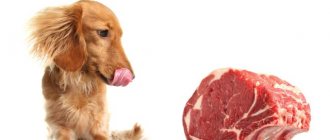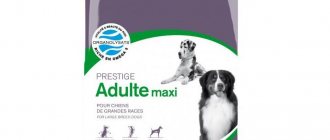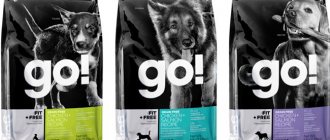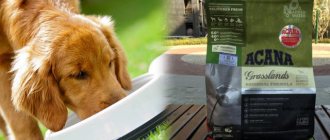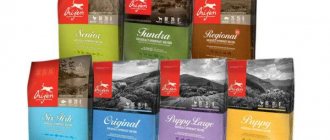Features of the food
Go Natural Holistic is a Canadian food produced since 1999 by Petcurean, which demonstrates a fairly long presence of this food on the international market. An important advantage for which we can only praise the manufacturers is their frankness. They honestly declare that all the products they use belong to the class of holistic natural feeds. Despite this, it is not licensed as “human grage” (holistic, human use is acceptable) due to the fact that it is subject to other processing methods. The food also contains animal meat imported from Australia and New Zealand.
Everything related to pricing issues is quite acceptable. Thus, a 230-gram bag of food will cost the owner 230 rubles, a 5-kilogram bag will cost the owner 2,500 rubles. An 11-kilogram bag of feed will cost about 4 thousand rubles. Next, we will analyze in detail the composition of the feed of this line.
This company focuses on the production of food from fresh meat and natural farm products.
The manufacturers of this food are members of the American Dog and Cat Products Alliance. In addition, they are also part of the Canadian Pet Products Committee. Strict food quality control by Canadian associations guarantees customers the proper quality of goods.
Among other things, this food is a member of the 10 best dog foods in the world (according to WHOLE DOG JOURNAL). High quality products can reduce food consumption by 30-40%. Go food manufacturers note a number of differences in their brand of dog food. First of all, these are the so-called human grade products, that is, meat, fruits, vegetables and grains made using technologies that are used in human nutrition. And this is true, because the company still received permission for these products from the Canadian government.
The average cost of Go natural holistic products is presented in the table below
Ingredients
The first thing stated in GO Natural Holistic food is meat. Most often, 40 to 54% chicken is used. This is a relatively good indicator for this price category. It is also very good that manufacturers directly indicate the addition of chicken fat to the composition, and not animal fat.
How to properly give this food to your pet?
| Dog weight, kg | Norm for puppies, grams/day | Norm for active dogs, grams/day | Norm for passive dogs, grams/day |
| 1-2,3 | 42-85 | 34-68 | 25-51 |
| 2,3-4,5 | 85-144 | 66-115 | 51-86 |
| 4,5-9 | 144-173 | 115-144 | 86-115 |
| 9-13,6 | 173-230 | 144-201 | 115-173 |
| 13,6-23 | 230-316 | 201-259 | 173-230 |
| 23-32 | 316-431 | 259-374 | 230-288 |
| 32-41 | 461-489 | 374-403 | 288-345 |
| 41-50 | 489-601 | 403-474 | 345-411 |
| 50-64 | 601-661 | 474-546 | 411-460 |
Why dry food?
Let's first briefly talk about the benefits of dry food. With them on the market, more and more dog breeders are giving them preference and there are reasons for this:
- The first, of course, is convenience and you can’t argue with that (pour in the food and it’s all done);
- Dry food is an easy way to provide your dog with balanced, nutritious nutrition (at least premium food). With them, you don’t need to worry too much about whether your pet has received all the vitamins, microelements and nutrients - you can be sure that everything;
- If necessary, you can choose a therapeutic or special diet that will meet the needs of your pet at a certain period of its life (pregnancy, illness, active loads, obesity, allergies, etc.);
- Feeding industrial products is more profitable from a financial point of view. The amount of dry dog food per day is incomparably less than the volume of a nutritious “lunch” made from natural products and its cost.
- And finally, saving time that will have to be spent on cooking every day.
Manufacturer and official website
Petcurean produces ready-made pet food. Note that the company owns several popular brands, but “GO” is presented as a flagship.
The manufacturer and official website (gonatural.ru) classify GO food as a holistic class and claim that the products are created using formulas that take into account the needs of dogs of all sizes and breeds. The food does not contain GMOs, by-products or dyes. The ingredients for the feed belong to the Human Grade class.
Is it possible to feed a dog only dry food all the time?
Many people worry about whether it is possible to constantly feed the dog only dry food? Some, fearing the possible consequences of such a monotonous diet, try to diversify their pet’s diet by mixing food from their own table into the bowl. Let's try to understand the consequences of this approach.
Mixed nutrition and its consequences
- Dry food + meat = excess protein. Protein overfeeding puts a strain on the kidneys, which subsequently leads to kidney failure, provokes degenerative changes in the liver, and can also cause allergies.
- Dry food + fish = excess phosphorus. Excessive intake of microelements contributes to the development of urolithiasis. As a result of accumulation, the liver and intestines are affected, anemia develops, the number of leukocytes decreases, and minor hemorrhages appear. Bone tissues lose calcium and accumulate phosphates, which leads to the development of osteoporosis, and in puppies to rickets.
- Dry food + porridge = excess carbohydrates. As a result, excess weight gain and related problems.
- With a mixed type of diet, owners “terrorize” the gastrointestinal tract, which provokes the development of chronic gastritis.
Treats are not contraindicated when feeding dry food. You can give pieces of finely chopped cheese, boiled meat, dried fruits or crackers.
Risks associated with mono-feeding
Ok, we’ve sorted out a little about the mixed type of nutrition. But what about feeding your dog only dry food? What risks might there be with this approach? For example, there is a myth that dry food negatively affects the gastric mucosa, gradually destroying it. The answer here is obvious - if dry food were harmful to dogs, it would not be produced in millions of tons around the world. Before producing this or that food, technologists develop it, test it for palatability in animals, conduct laboratory tests for safety and a host of other indicators. This also applies to inexpensive food and holistic food. Moreover, dry food is developed primarily for mono-feeding - that is, it is initially assumed that they will be fed only with them, and not added to the food as a “yummy”.
Diseases in animals are another matter - dogs, like people, have their own sores and weaknesses, and this must be taken into account. Problems with the gastrointestinal tract are also not uncommon, and if your veterinarian recommended giving up dry food, then this certainly needs to be done.
FEEDING RATES FOR DOGS The most common question about dog nutrition is the question about feeding standards. All manufacturers place tables with the recommended amount of feed on the packaging. These nutritional guidelines are a legal obligation for manufacturing companies. However, there is not complete consistency in the principles of setting standards between many brands. Some companies deliberately list very low quantities to convince consumers of the economic benefits of purchasing their food. In any case, the recommendations on the food packaging are just guidelines, not an absolute rule. There is a wide range of recommendations for feeding dogs depending on age, activity, breed, living conditions, ambient temperature, etc. This is why the amounts listed in the table are most often not optimal for your specific dog. You should consider the following points and adjust feed volume accordingly: 1. Rate tables only consider maintenance requirements. For active dogs, the amount of food required may be 20% higher, or more depending on the duration and intensity of exercise. 2. For extreme physical exertion, such as that of sled dogs during competitions, the demands may be 3-4 times higher than standard. On the other hand, many dogs are overweight and inactive. Pets that live in the house are especially inactive. Be careful not to overfeed your dog. For an overweight dog, diet should be based on optimal target weight rather than actual weight. Ask your veterinarian if you are unsure about the ideal weight for your pet. Other factors such as outside temperature. For dogs that live outside the home, additional energy is needed to maintain body temperature. For this reason, norms in winter can be 3 times higher than on hot summer days. Last but not least, the dog’s “physiological status” affects nutritional requirements. During growth, pregnancy and lactation there are important additional needs for the construction of new body tissues. During lactation, needs increase 3-4 times. In older dogs, activity and metabolism slow down, and the need for food decreases accordingly.
Feeding standards for dogs
The norms for feeding dogs with dry food are individual indicators. They depend on several factors: food class, dog size, physiological condition, activity and age.
Feed class and energy value
Industrially produced feeds are conventionally divided into 4 classes, which differ in the quality of ingredients used in production, balance, nutritional and energy value (Kcal/100g).
- Economy class feed has an energy value of 250-300 Kcal. They are made from low quality products and require the introduction of vitamin and mineral supplements into the diet.
- Premium class has a nutritional value of 300-350 Kcal. Its advantage is an increase in the amount of animal proteins in the form of by-products and waste, as well as the inclusion of vitamins and microelements.
- Super-premium food is a balanced, complete diet suitable for regular feeding. Energy value 360-450 Kcal.
- Holistic class food with an energy value of 360-450 Kcal differs from the super-premium class in that it is produced from the highest quality products approved for the food industry.
GO food range
The GO food range consists of three lines. Each line belongs to the holistic class.
- GO! FIT + FREE is a line of grain-free food.
- GO! SENSITIVITY + SHINE – food for dogs with allergies or pets suffering from digestive sensitivity.
- GO! DAILY DEFENCE – food with whole grain cereals.
There are only three lines, but this is not surprising; holistic products are never produced in a large assortment.
GO! FIT+FREE
GO! FIT + FREE is the only food, also known as a line. The advantage of the diet is the absence of grains. The food is suitable for dogs of all ages and breeds. Below, we will look at its composition in detail.
GO! SENSITIVITY + SHINE
Let's take a look at the GO! SENSITIVITY + SHINE. Let's start with feeds that do not contain grains and potatoes. Main advantages:
- It is based on one type of meat.
- Suitable for animals with sensitive digestive systems.
- The composition contains probiotics, prebiotics, fatty acids, antioxidants.
- Contains no gluten, chicken, or soy.
- The food is suitable for puppies and adult dogs.

